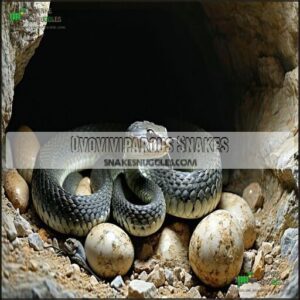This site is supported by our readers. We may earn a commission, at no cost to you, if you purchase through links.
 Snakes can either lay eggs or give birth to live young, depending on their species.
Snakes can either lay eggs or give birth to live young, depending on their species.
Most snakes fall into the egg-laying category, or "oviparous," like cobras and pythons, which lay eggs and sometimes guard their nests.
Others, like boa constrictors and rattlesnakes, are "viviparous," meaning they give live birth—no eggs involved.
Then there’s a third group, "ovoviviparous" snakes, like garter snakes, which grow their eggs internally before hatching.
This strategy helps them adapt to harsher climates where laid eggs might not survive, and it’s nature’s way of saying, “Work smarter, not harder.”
Curious about which snakes break the mold? Stick around!
Table Of Contents
- Key Takeaways
- Snake Reproduction Methods
- Characteristics of Snakes
- Do Snakes Lay Eggs or Give Birth?
- How Many Eggs Do Snakes Lay?
- Snakes That Give Live Birth
- How Are Marine Snakes Born?
- Factors Affecting Snake Reproduction
- Parental Care in Snakes
- Common Myths About Snake Reproduction
- Frequently Asked Questions (FAQs)
- How do snakes give birth?
- Do snakes give birth or lay eggs?
- Do snakes give live birth?
- Do sea snakes lay eggs?
- Do snakes lay eggs asexually?
- Can snakes lay eggs through their mouths?
- Are snakes born eggs or babies?
- How many eggs does a snake lay?
- Do snakes give birth to live offspring?
- What kind of snakes give live birth?
- Conclusion
Key Takeaways
- Snakes use three reproduction methods: laying eggs (oviparity), giving live birth (viviparity), or hatching eggs internally before live birth (ovoviviparity).
- About 70% of snake species lay eggs, while 30% give live birth, adapting based on their environment and climate.
- Live-birthing species like boas and rattlesnakes thrive in colder or challenging conditions where eggs wouldn’t survive.
- Egg-laying snakes, like cobras and pythons, rely on warm, hidden nesting sites for their soft, leathery eggs to develop safely.
Snake Reproduction Methods
Snakes have fascinating ways of bringing their young into the world, ranging from laying eggs to giving live birth.
These methods—oviparous, viviparous, and ovoviviparous—reflect how snakes adapt to different environments and survival challenges.
Oviparous Reproduction
Oviparous snakes, forming 70% of species, amaze with their egg-laying strategies.
Eggs are fertilized internally and develop with protective, leathery shells. Females, after laying them in warm spots, leave the clutch to nature.
- Highlights About Oviparity:
- Eggs rely solely on yolk for nourishment.
- Clutch sizes vary widely.
- King cobras fiercely guard nests.
- Incubation periods depend on temperature.
- Hatchlings are independent immediately.
Viviparous Reproduction
Viviparous snakes, like boa constrictors, skip eggs altogether and give birth to live young.
Their embryos grow inside the mother, nourished by a placenta and yolk sac, showcasing impressive maternal investment.
Here’s a quick look:
| Feature | Viviparous Snakes | Benefits | Example Species |
|---|---|---|---|
| Placental Nourishment | Yes | Consistent nutrients | Boa Constrictors |
| Eggshell Presence | Reduced | Improved survival | Green Anacondas |
| Climate Adaptation | Colder zones | Safer reproduction | White-lipped Snakes |
| Evolutionary Benefit | Advanced birth style | Higher survival rate | Garter Snakes |
This evolution helps livebearing snakes thrive where egg-laying doesn’t work, thanks to their ability to adapt to colder zones.
Ovoviviparous Reproduction
Ovoviviparous snakes are nature’s clever multitaskers, combining traits of both oviparous and viviparous snakes. These snakes practice egg retention, keeping eggs safely inside their bodies during development. Instead of laying eggs, they let the embryos hatch internally, giving birth to live young. Talk about a built-in nursery!
Ovoviviparous snakes master survival by hatching eggs inside their bodies, creating a built-in nursery for live births!
This incredible process protects the young from predators or harsh environments and guarantees independence right after birth. Inside their mother, embryos form in membrane encasements, relying on yolk nourishment for growth.
You’ll find viper examples like rattlesnakes perfecting this art of ovoviviparity, balancing safety and survival. Nature always seems to have a backup plan!
- Live birth guarantees safer survival for the young.
- No abandoned eggs mean reduced risk of predators.
- Hatchlings are independent and ready for life immediately.
Characteristics of Snakes
Snakes are fascinating creatures with unique physical traits, like their elongated bodies and lack of limbs, helping them adapt to various environments.
Their behavior, from hunting to reproduction, reveals an incredible ability to survive in some of the harshest conditions on Earth, showcasing their adaptation.
Physical Characteristics
Snakes are like nature’s puzzle masters, perfectly adapted to their environments.
Their scales protect their sleek body shape while aiding movement across rocky, sandy, or forested terrain.
Vibrant coloration can offer camouflage or warn predators to stay back.
Some use venom to hunt, while others rely on sheer size to overpower prey.
With no eyelids and their iconic unblinking gaze, they spot danger and prey effectively.
These traits make snake reproduction—be it through snake eggs or live births—equally fascinating.
Behavioral Characteristics
Snakes keep life simple—with minimal social behavior.
They’re mostly loners, except during mating rituals where pheromones do the talking.
Their world revolves around:
- Hunting strategies: Striking prey with precision.
- Defensive behavior: Relying on venom or camouflage.
- Territorial instincts: Avoiding unnecessary confrontations.
- Communication methods: Silent, scent-based exchanges.
Whether oviparous or viviparous, their survival mindset leaves no time for small talk!
Environmental Adaptations
Snakes have mastered the art of adapting to their surroundings. Whether they’re gliding through deserts or resting in dense forests, they tailor their reproductive strategies to boost survival rates.
Reproductive methods aren’t random—they’re clever responses to the environment.
- Reproductive strategies like laying snake eggs are common in warmer climates, where incubation isn’t a challenge. Oviparous snakes find hidden spots with stable temperatures.
- In colder areas, viviparous snakes skip egg-laying entirely, keeping their young warm inside until live birth.
- Geographic variation plays a huge role—snakes in isolated or tough terrains evolve unique habits to guarantee snake birth success.
- Climate influence disrupts these patterns, nudging some snake reproduction methods to shift with changing ecosystems.
Do Snakes Lay Eggs or Give Birth?
You might be surprised to learn that snakes can lay eggs, give live birth, or even do a bit of both.
These fascinating methods—called oviparity, viviparity, and ovoviviparity—depend on the species and their environment.
Oviparous Snakes
If you’ve ever wondered how egg-laying snakes manage their offspring, it’s fascinating.
Female oviparous snakes, like cobras and pythons, deposit soft, leathery eggs in warm nesting locations. Most abandon the clutch, leaving hatchlings fully independent.
Understanding snake reproduction basics is key to appreciating their life cycle.
Incubation habits vary:
Incubation Factor Cobras Pythons
Viviparous Snakes
Braving tough conditions, viviparous snakes take reproduction to the next level by giving birth to live young, skipping the need for external eggs. This fascinating process relies on placental development, where moms provide direct maternal nourishment to embryos. It’s like nature’s ultimate baby carrier, perfectly designed for survival.
Here’s why livebirth advantages matter:
- Safer Development: Keeping embryos inside reduces predator risks.
- Cold Climate Adaptation: Viviparous snakes thrive in chilly places where eggs wouldn’t survive.
- Environmental Flexibility: This method embraces unpredictable habitats.
- Egg Reduction: No fragile eggs mean more energy for healthy offspring.
Boa constrictors are champions of viviparity evolution, making reptile reproduction even more intriguing!
Ovoviviparous Snakes
Unlike their viviparous cousins, ovoviviparous snakes take reproduction to another level by blending egg retention with live birth.
Inside the mother, embryos develop within eggs, relying on yolk dependence for nourishment. When ready, these eggs undergo internal hatching, followed by membrane birth as live, self-sufficient offspring emerge.
This ingenious method shields vulnerable young from predators and harsh environments. Viper examples, like rattlesnakes, highlight this snake life cycle adaptation.
It’s nature’s way of ensuring survival in the unpredictable world of reptile reproduction and snake breeding, showcasing an remarkable adaptation for reproduction.
How Many Eggs Do Snakes Lay?
You might be surprised to learn that some snakes lay just a few eggs, while others can lay over a hundred at a time.
The exact number depends on the species, with factors like size and habitat playing a big role.
Factors Affecting Egg-Laying
In the context of egg-laying snakes, several environmental factors influence how and where they lay their eggs.
Female health plays a big role—well-fed snakes tend to produce larger clutches. Climate influence, like temperature and humidity, is key for oviparous species. Eggs need warmth but can’t get too hot or overly dry.
Female snakes usually select perfect nesting sites to keep their eggs safe.
Here are three important points:
- Nesting sites: Females lay eggs in soil, leaf litter, or hidden spots to protect them from predators.
- Clutch size: Larger clutches demand secure, spacious areas.
- Eggshell composition: Soft, leathery shells resist drying and survive in humid conditions.
Nature’s precision makes these oviparity strategies thrive.
To improve hatching rates, consider using a snake egg incubator.
Egg Incubation Period
Egg incubation in oviparous snakes is like nature carefully fine-tuning a recipe.
The Temperature Effects and Humidity Levels play a big role in the 55-100 day Incubation Length. These eggs aren’t like hard chicken eggs—they’re soft, leathery, and rely on moisture to prevent drying out.
Female snakes strategically choose spots like warm sand or moist leaf piles for Hatching Success. While snake moms usually skip out on childcare, their thoughtful egglaying prep creates the ideal environment for embryo development, ensuring the little ones are ready for the world!
Clutch size varies depending on the species.
Snakes That Give Live Birth
Not all snakes lay eggs—some actually give live birth, which might surprise you.
Boa constrictors, green anacondas, and rattlesnakes are just a few examples of species that bring their young into the world this way.
Boa Constrictors
Boa constrictors, fascinatingly, stand out as viviparous snakes, meaning they give birth to live young rather than laying eggs like oviparous species.
Thanks to Boa Viviparity, baby boas (called neonates) develop inside the mother, nourished through Placental Development for 100-120 days.
After birth, these tiny slitherers are immediately self-reliant, showcasing remarkable Neonate Independence.
Litters range from a few to over 60, with Size Variation depending on species and conditions.
Unlike egg-laying snakes, boas’ unique Mating Rituals reflect their adaptability to warm rainforests, offering a compelling glimpse into viviparous diversity.
They carry embryos for an average of 100-150 days, a key aspect of live-bearing snake species.
Green Anacondas
Green anacondas are the heavyweights of viviparous snakes, trading egg-laying for live birth, perfectly matching their watery South American homes.
Unlike oviparous snakes, they’ve adapted to avoid the predation risks eggs face by nurturing their young internally.
These giants deliver impressive neonates, with litters of 20-40 babies that are ready to swim and hunt from day one. Surprisingly, newborns already measure 2-3 feet long—talk about starting big!
- Embryos develop inside mom, fed by yolk sacs.
- Habitat influence guarantees protection in their wet environments.
- Occasionally, anacondas exhibit asexual reproduction—no male needed!
A mother’s instinct? Reproduce, release, and relax!
Rattlesnakes and Vipers
Rattlesnakes and vipers crush the parenting game with their ovoviviparous reproduction, skipping eggshells entirely for convenient live births.
These viviparous snakes thrive in harsh terrains by developing offspring internally.
Fascinating adaptations include:
- Venom Development: Hatchlings emerge fanged, venomous, and survival-ready.
- Thermal Regulation: Internal development shields embryos from cold.
- Viper Evolution: This strategy expands survival in predator-heavy or rocky areas.
- Parental Investment: No burdensome nests – freedom to hunt and evade predators.
No wonder rattlesnakes thrive worldwide!
How Are Marine Snakes Born?
In the context of marine snakes, they’ve got reproduction all figured out for life in water. Most sea snakes are ovoviviparous, meaning they give birth to live young rather than laying eggs on land like other species.
This adaptation makes certain their young are born directly into their aquatic environment, ready to fend for themselves.
- Developing embryos stay safely in the mother’s body, protected from predators.
- Hatchlings are born fully formed and independent, equipped with venom for survival.
- They don’t need crawling practice—newborns swim like pros.
- Viviparity advantages minimize risks like floating eggs or dry land shortages.
Species like sea kraits, however, use oviparity, laying eggs on land in tight crevices.
Factors Affecting Snake Reproduction
Snake reproduction depends on factors like climate, habitat, and evolutionary history, which shape whether they lay eggs or give live birth.
You’ll notice that snakes in colder regions often give live birth, while those in warmer areas typically lay eggs.
Climate and Geographic Location
Snakes don’t follow a one-size-fits-all rule in terms of reproduction. Climate and geographic location shape their strategies, proving they’ve mastered the art of survival.
If you’re in tropical areas, warm and humid conditions favor oviparous (egg-laying) snakes like most colubrids. Climbing higher into the mountains? You’ll often find viviparous snakes, relying on live birth to keep their young cozy.
Here’s a quick look:
| Habitat | Climate | Reproductive Strategy |
|---|---|---|
| Rainforests | Warm, humid | Oviparous |
| Mountains | Cold, variable | Viviparous |
| Desert Landscapes | Hot, dry | Ovoviviparous |
Whether they’re managing chilly altitudes or sandy deserts, snake reproductive strategies evolve perfectly with their habitats’ quirks. Fascinating, right?
Evolutionary History of Snake Reproduction
Snake evolution paints an incredible picture of adaptability, driven by environmental pressures and genetic adaptations.
Fossils reveal early oviparity, when all snakes laid eggs. Over time, cooler climates and survival needs sparked reproductive diversification, leading to new serpentine reproductive strategies.
Here’s the breakdown of their fascinating journey:
- Ancient snakes were oviparous, relying on external incubation.
- Viviparity origins began in cold climates, with embryos developing inside the mother.
- Ovoviviparous methods emerged as a hybrid solution.
These changes highlight how snakes mastered survival with ingenious reproductive strategies!
Threats to Snake Populations
Habitat loss from urban growth and agriculture leaves snakes scrambling for nesting spots, while climate change disrupts their temperature-dependent reproduction.
Human persecution, like poaching or unnecessary killing, adds to the mix. Pollution can ruin egg survival, hitting oviparous species hardest.
Disease outbreaks? They don’t discriminate—affecting viviparous, ovoviviparous, and oviparous snakes alike. Invasive species also compete for resources, pushing snakes further into trouble.
Stress from captivity can also lead to decreased appetite, impacting reproductive success.
Protecting snake habitats guarantees healthier populations and better chances for their offspring’s survival, which is crucial for the long-term survival of snake species and maintaining ecological balance.
Parental Care in Snakes
In the context of parenting, most snakes prefer the “hands-off” approach—lay the eggs or give birth, and let the babies figure it out.
Still, a few species, like the king cobra, surprise you with extra effort, showing rare examples of parental care in the snake world.
Limited Parental Care
After reproduction, most snakes embrace a “you’re on your own” parenting style. Whether laying eggs or giving birth, they skip the nurturing phase entirely. Their parental absence is a fascinating survival strategy fueled by evolutionary reasons.
Here’s how this hands-off approach works:
- Females lay reptile eggs or give birth (viviparous/ovoviviparous) in safe spots.
- Hatchling independence kicks in—young snakes rely on instincts.
- No cuddling here—there’s zero parental care in snakes after birth.
- Post-birth survival depends on minimal investment and natural selection.
Snakes thrive by betting on strength, not coddling, leaving nature to shape their future. To guarantee successful hatching, some reptile enthusiasts utilize a specialized egg incubator.
King Cobra’s Parental Care
Most egg-laying snakes skip parental duties, but a king cobra’s approach could surprise you. Among the few reptiles showing parental care, it’s a standout.
Female king cobras pour remarkable energy into nest construction, using leaves and debris to create a warm, decomposing blanket for their eggs. This level of parental investment doesn’t stop there:
- They coil protectively around the eggs, guarding them fiercely.
- Males may linger nearby, offering hatchling defense against predators.
- The warmth from the nest keeps eggs safe for months.
- Once the young emerge, parental roles end as the hatchlings grow independent.
They are native to dense forest habitats across Southeast Asia.
For an egg-laying snake, this cobra behavior truly redefines commitment.
Common Myths About Snake Reproduction
You’ve probably heard some wild claims about how snakes reproduce, but not all of them are true.
Let’s clear up these common myths so you can separate fact from fiction and impress your friends with the truth.
This will help you understand the process better and make informed decisions.
Do Snakes Lay Eggs From Their Mouths?
It’s a bizarre myth that snakes lay eggs from their mouths – but it’s totally untrue.
Snake anatomy doesn’t work that way. Eggs form in the oviduct, traveling through the cloaca for egglaying.
Their esophagus, connected to the mouth, handles food—not egg transport. This confusion might stem from seeing a snake regurgitate a meal.
Unlike viviparous or ovoviviparous snakes, oviparity involves eggs exiting the cloaca, not the mouth.
Mouth Egg Laying? Purely a myth with no scientific backing!
Are All Snakes Born Alive or From Eggs?
Not all snakes are born the same way, and that’s part of their charm.
Snakes have mastered three diverse reproduction styles:
- Egg-laying snakes (oviparous) account for 70% of species, leaving eggs to hatch independently.
- Live birthing snakes (viviparous) nurture fully-formed young inside, offering a head start.
- Ovoviviparous species combine both, with eggs hatching internally before live birth.
Snake evolution showcases reproductive diversity, adapting strategies like viviparity or oviparity based on climate and survival needs.
Nature’s ingenuity, right?
Separating Fact From Fiction in Snake Reproduction
Understanding myths about snake reproduction clears up some wild ideas! Did you know snakes have three unique reproductive methods?
| Method | How It Works | Examples |
|---|---|---|
| Oviparous | Eggs laid outside the body | Cobras, Rat snakes |
| Viviparous | Live birth via placenta | Boas, Sea snakes |
| Ovoviviparous | Eggs hatch inside mom | Rattlesnakes |
Contrary to myths, no snake lays eggs from its mouth—that’s pure fiction.
Egglaying snakes rely on oviparity, while viviparous and ovoviviparous species adapted for Environmental Influence.
Their Uncommon Adaptations and Evolutionary Advantages guarantee survival, no matter clutch size or habitat.
Frequently Asked Questions (FAQs)
How do snakes give birth?
Some snakes give live birth, nourishing their young internally through a placenta or yolk sac.
Others hatch their eggs inside their body before "live" babies emerge.
It’s nature’s unique way of keeping options open, with complete concepts like these showcasing the diversity in snake reproduction.
Do snakes give birth or lay eggs?
About 70% of snakes lay eggs, while 30% give live birth.
It all depends on the species and environment.
From rattlesnakes to boa constrictors, nature’s flexibility guarantees survival in wildly different habitats.
Do snakes give live birth?
Yes, some snakes give live birth.
About 30% of species, like boa constrictors and rattlesnakes, either nurture embryos internally or retain eggs until hatching.
It’s a clever strategy for surviving colder climates or tricky environments.
Do sea snakes lay eggs?
Ever wondered if sea snakes lay eggs?
Most give live birth in water, perfectly suited for their aquatic life.
However, one exception, the sea krait, lays eggs on land.
Nature always keeps us guessing with its unexpected ways!
Do snakes lay eggs asexually?
Some snakes can hatch eggs asexually through parthenogenesis, where females produce offspring without mating.
It’s rare, but species like green anacondas and garter snakes can pull it off, creating perfect genetic clones of themselves.
Can snakes lay eggs through their mouths?
You won’t find snakes laying eggs through their mouths.
They reproduce through oviparity, viviparity, or ovoviviparity, with eggs or live young emerging from their bodies, not mouths, in these unique processes.
Are snakes born eggs or babies?
Picture a tiny snake emerging—sometimes cracking open an egg, other times squirming free from its mother.
It depends! Some snakes lay eggs (oviparous), while others give live birth (viviparous or ovoviviparous).
How many eggs does a snake lay?
The number of eggs a snake lays depends on the species—anywhere from a few to over
Most choose sheltered spots with the right humidity and temperature to guarantee their soft, leathery eggs develop properly.
Do snakes give birth to live offspring?
Yes, some snakes give birth to live offspring.
Species like boa constrictors and rattlesnakes either nourish their young internally or hatch eggs inside before birth, making them amazing examples of nature’s adaptability and survival strategies.
What kind of snakes give live birth?
Live-bearing snakes include boas, anacondas, vipers like rattlesnakes, and most water and sea snakes.
They nourish their young internally, offering advantages like better survival in cold climates or aquatic habitats.
It’s nature’s flexible strategy, offering a clear benefit in terms of survival.
Conclusion
So, do snakes lay eggs or give birth? The answer is both, and it depends on the species.
Some lay eggs (oviparous), others give live birth (viviparous), while a few do both—sort of (ovoviviparous).
This amazing variety helps them thrive in different environments.
Whether they’re coiled around a nest or birthing live young, snakes show nature’s incredible adaptability.
Next time you spot a snake, remember—its reproduction might just be as fascinating as its slither!
- https://www.quora.com/Do-all-snakes-give-birth-through-the-laying-of-eggs
- https://pets.stackexchange.com/questions/18165/do-snakes-give-birth-to-live-young-or-lay-eggs
- https://dirtyclassroom.com/snake-reproduction-mallory-schmackpfeffer/
- https://www.reddit.com/r/snakes/comments/b9uhpg/70_of_the_worlds_snakes_lay_eggs_but_the_other_30/
- https://www.worldanimalprotection.org.nz/education/animal-facts/snakes/



















